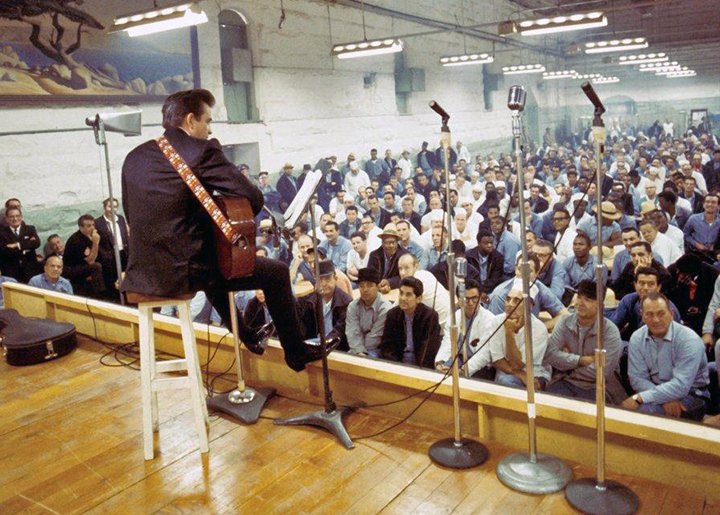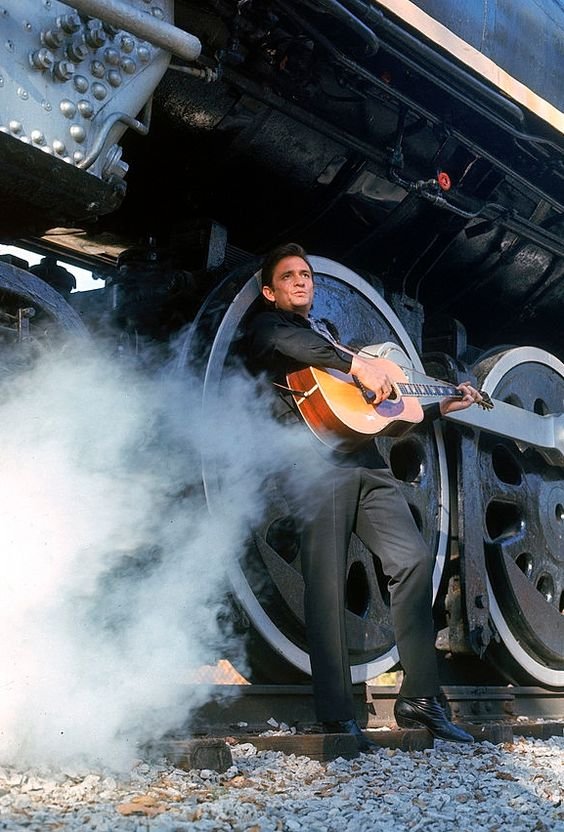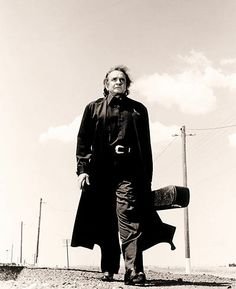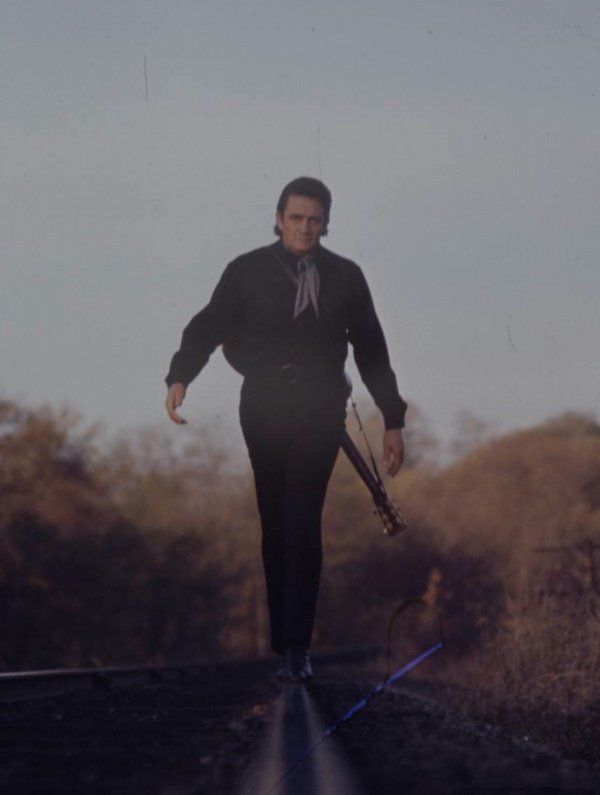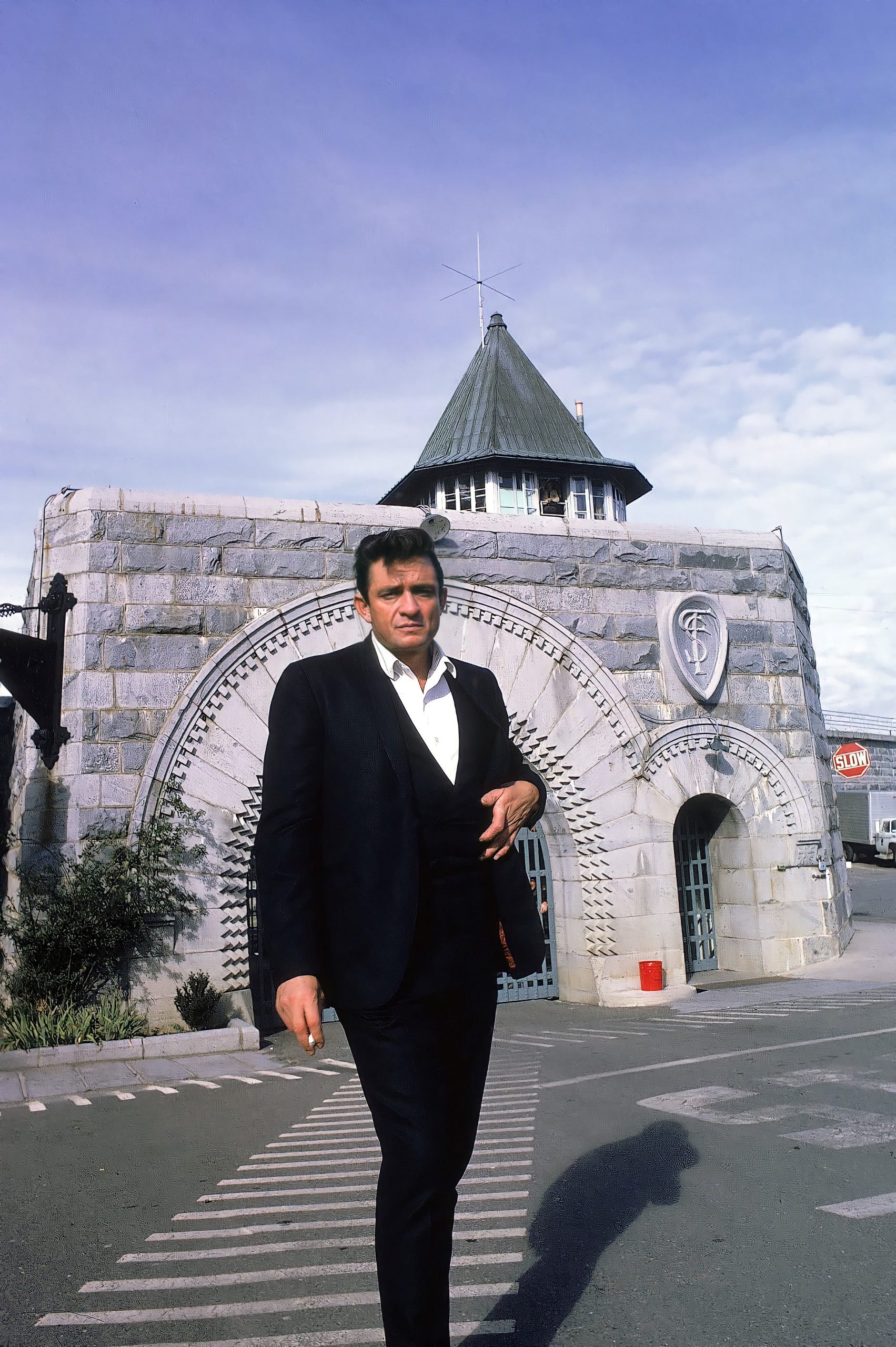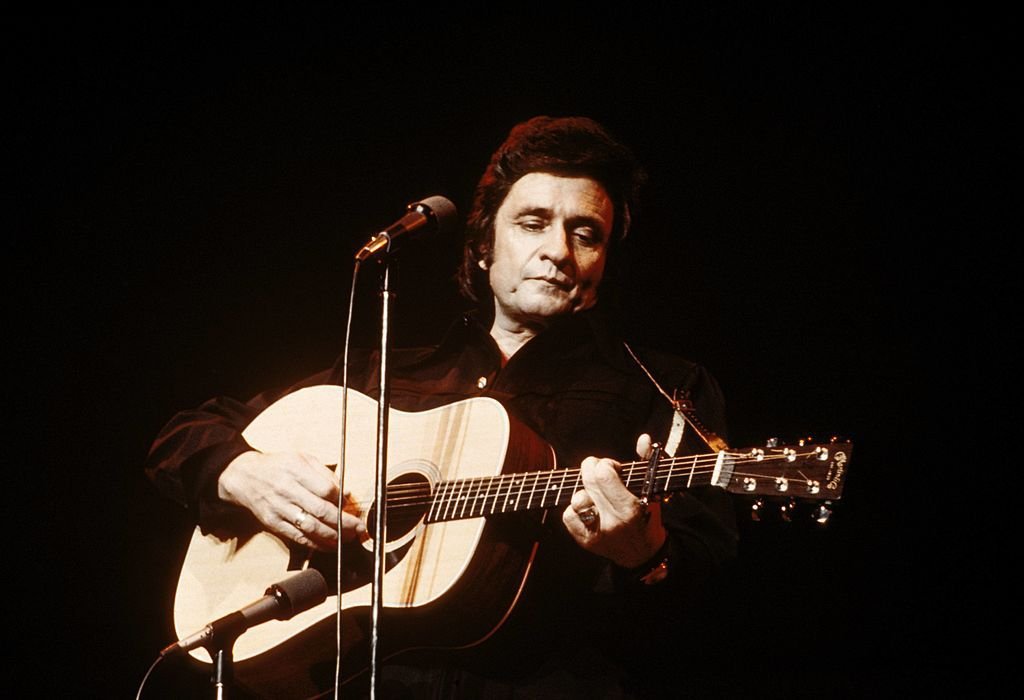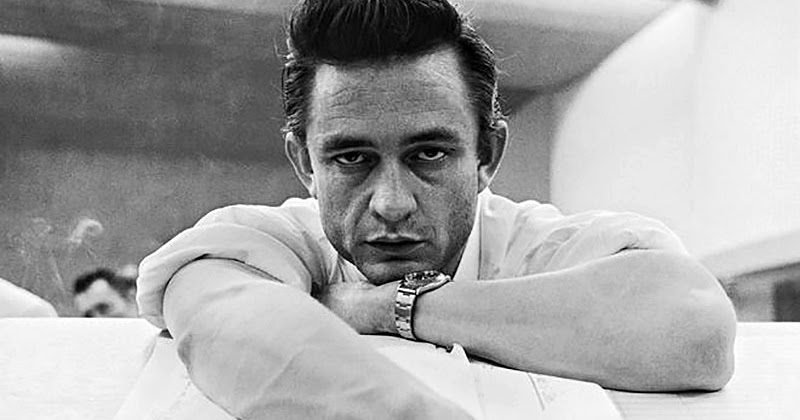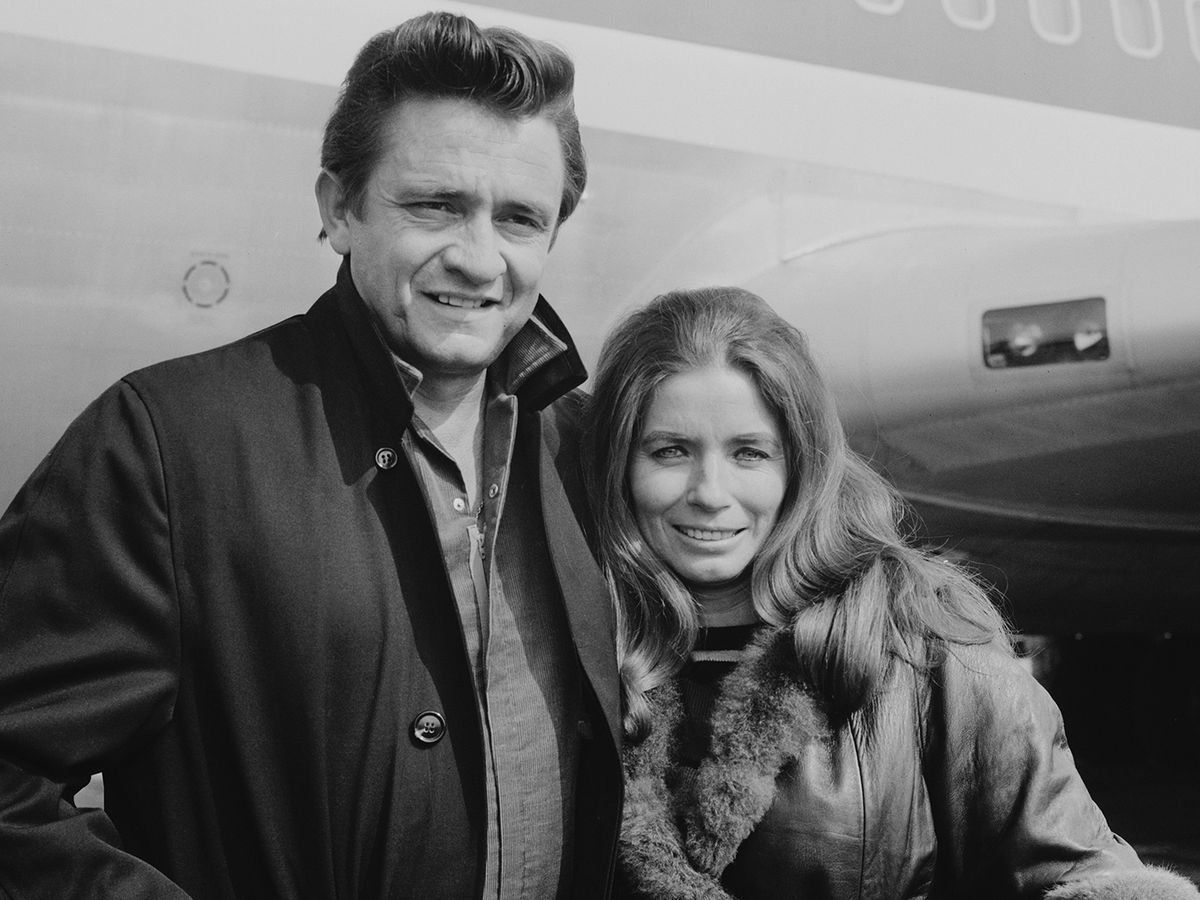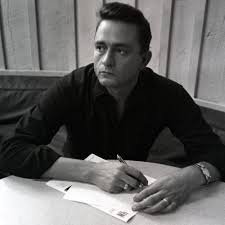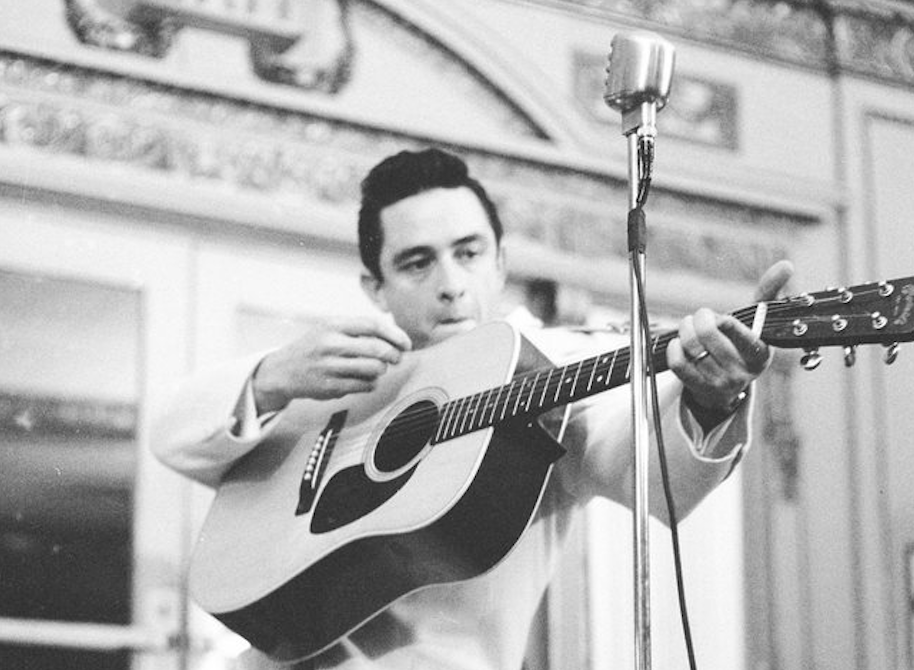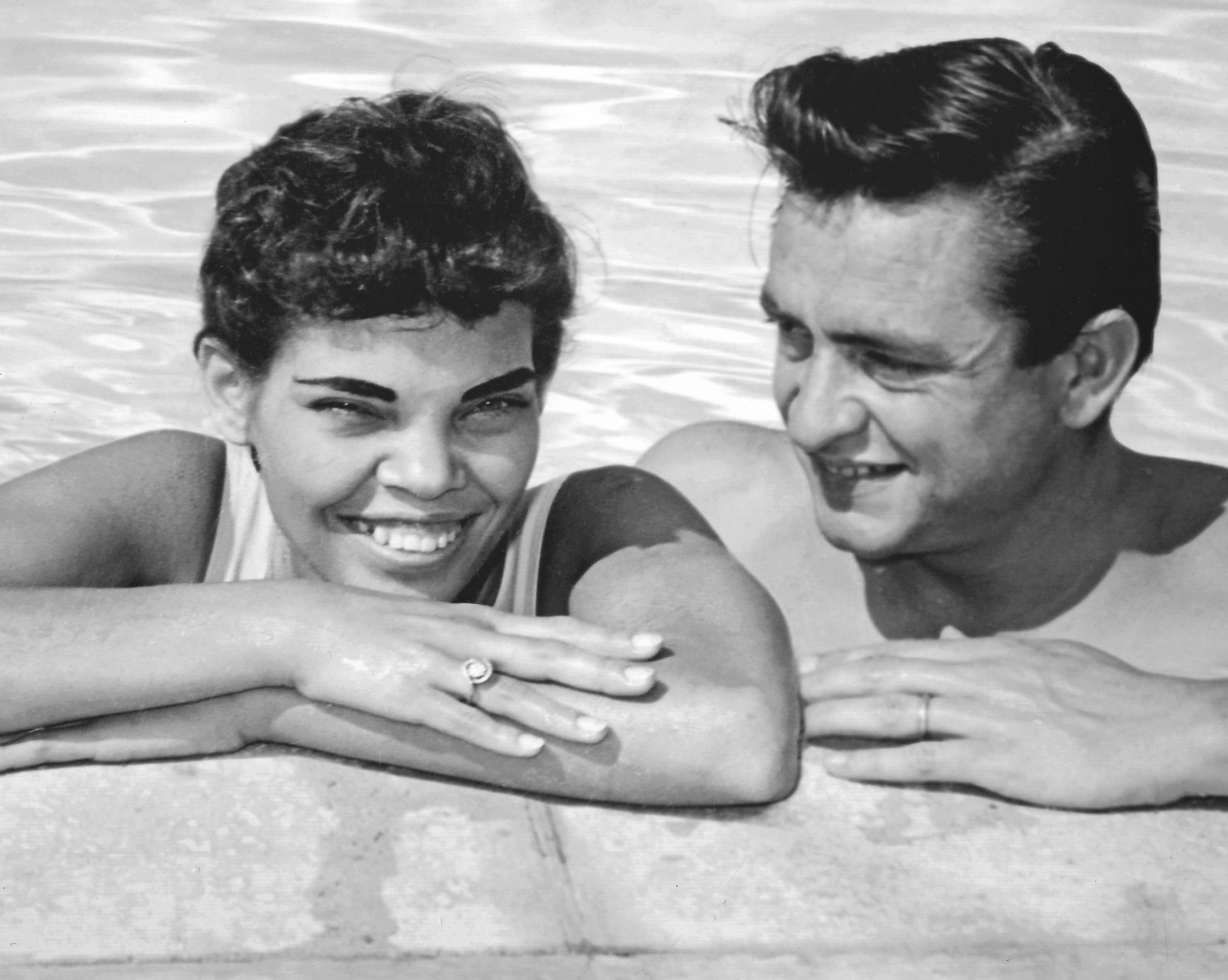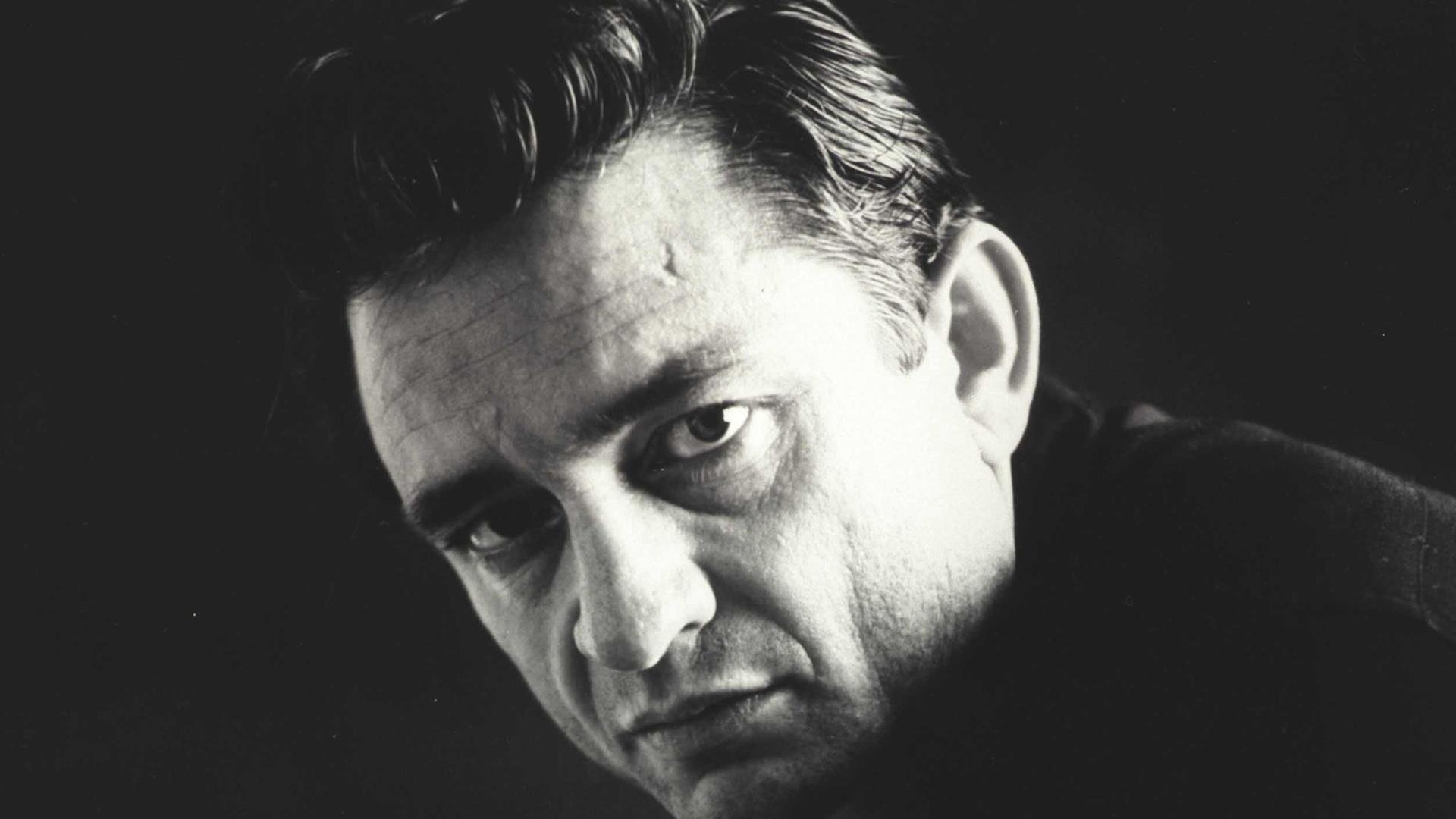Johnny Cash
Man in Black
J. R. Cash was born on February 26, 1932 in Kingsland, Arkansas. His parents are Carrie and Ray Cash, and his siblings are Roy, Louise, Jack, Reba, Joanne, and Tommy. In early 1935, the family moved from Kingsland to Dyess, Arkansas, a New Deal agricultural colony enacted by President Franklin D. Roosevelt that gave families a home and land that they might be able to own after many years of work, and by the time he was five years old, he was working the cotton fields with his family. Tragedy hit the family in May 1944, when Jack, who was very close to J. R., was in a sawmill accident and would die a week later. His brother’s death would haunt him for the rest of his life. Jack, even though he was young, was hoping to be a preacher and would study the Bible. J.R. would honor Jack by recording gospel albums throughout his career. Growing up in Dyess, music was always around. J. R. would sing with his family while they where out in the fields, hear gospel music in church, listen to country music on the radio show the Grand Ole Opry, and listen to the blues. A couple of his favorites were Jimmie Rodgers, The Carter Family, Sister Rosetta Tharpe, and The Louvin Brothers. By the age of 12, he was playing guitar (he was taught by his mother and a childhood friend), and writing songs and poems. While in high school, he sang on a local radio show (KLCN) in Blytheville and worked odd jobs. After graduating high school and trying his hand at auto body plant for a short while in Michigan, he enlisted in the U.S. Air Force on July 7, 1950 as John R. Cash. He went to San Antonio, Texas for training, and while there he met his future wife Vivian Liberto. John was then sent to Landsburg, West Germany where he worked as a morse code operator. While in Germany, he bought his first guitar and formed a band called The Landsburg Barbarians. He would write a couple of songs during this time that he would later record, “Folsom Prison Blues”, “Hey Porter”, “Wide Open Road”.
In July 1954, John was honorably discharged and went back to San Antonio to marry Vivian. They were married on August 7 and the couple would have four daughters: Rosanne (born in 1955), Kathy (1956), Cindy (1959), and Tara (1961). The couple then moved to Memphis, Tennessee where he worked as a home appliance salesman and studied to become a radio announcer. His brother Roy, who also lived in Memphis, would introduce John to two of his co-workers, Luther Perkins and Marshall Grant. The three soon formed a band with John and Luther playing guitars and Marshall on upright bass. After a while, they were hired to play on a local radio station (KWEM) and in churches. In late 1954, John would go to Sun Records looking for a recording contract. John, Luther, and Marshall auditioned for Sam Phillips, the owner and producer, who liked their unique “boom-chicka-boom” sound but wasn’t interested in the gospel songs they were playing and told them to come back when they had a some original songs. They returned with John’s songs “Hey Porter” and “Cry, Cry, Cry” which earned them a contract and a name for the band, Johnny Cash and the Tennessee Two. The two songs were released in early 1955 and went to number 14 on the country charts. They then went on tour and released their second single, “Folsom Prison Blues” and “So Doggone Lonesome”, that would go to number four. His first number one single, and one of my absolute favorite songs of all time, would be released in May 1956, “I Walk the Line” backed with “Get Rhythm”. Three more songs would become number one hits: “There You Go” (1957), “Ballad of a Teenage Queen” (1958), and “Guess Things Happen That Way” (1958). By 1956, Johnny was performing on the hit radio show Louisiana Hayride in Shreveport, Louisiana and on July 7, he played his first show on Grand Ole Opry in Nashville. Backstage before he went on the Opry stage, he met his future second wife, June Carter of the Carter Family. That same year, on December 4, an infamous jam session happened at Sun Studios. Carl Perkins was recording some new songs with Jerry Lee Lewis playing piano when Elvis Presley stopped by. At some point Johnny showed up and Sam Phillips decided to record what we know as The Million Dollar Quartet. It wasn’t until 1981 when some of the songs were released in Europe. Then in 1990, the full session was released in the U.S. and Europe. Johnny’s first album was released in October 1957, Johnny Cash with His Hot and Blue Guitar!, which was also the first album an artist on Sun released. My favorite songs from this album, besides the four hit singles, are “Rock Island Line”, “Country Boy”, and “I Was There When It Happened”. Two other singles released on Sun that I love are “Home of the Blues” (1957) and “Big River” (1958).
In 1958, Johnny left Sun and signed with Columbia Records. After he left Sun, Sam Phillips would continue to release Johnny’s music until 1964. My favorite songs and albums that Sun released are Sings the Songs That Made Him Famous (1958), Sings Hank Williams (1959), “Mean Eyed Cat” (1960), “Oh Lonesome Me” (1960), “Sugar Time” (1961), “Blue Train” and “Train of Love” (All Aboard the Blue Train, 1962), “Wide Open Road” (1964) and “Goodnight Irene” (Original Sun Sound of Johnny Cash, 1964). His first number one single with Columbia was “Don’t Take Your Guns to Town” and first album was The Fabulous Johnny Cash, which went to number 19. Two other great songs from this album are “That’s Enough” and “I Still Miss Someone”. Two albums were released in 1959, Hymns by Johnny Cash and Songs of Our Soil. My favorite songs are “I Saw a Man”, “The Old Account”, “Lead Me Father”, “These Things Shall Pass” (Hymns by Johnny Cash), “Five High and Rising”, “The Man on the Hill”, “The Great Speckle Bird”, and “The Caretaker” (Songs of Our Soil). By the end of the 1950’s, Johnny Cash was one of the best selling and most popular artist at the time.
During the 1960’s, there were many highs and many lows for Johnny. In 1960, drummer W. S. “Fluke” Holland joined and the band was then called the Tennessee Three. The next year the Carter Family (Mother Maybelle, June, Helen, and Anita) joined Johnny on tours and albums. In 1961, Johnny, Vivian, and the kids moved to California and he starred in his first movie (Five Minutes to Live). While on tour in the late 1950’s, he became addicted to pills and was drinking heavily. By the early 1960’s he was out of control and his hectic behavior led to many problems in his personal life. Vivian and the kids rarely saw him and Vivian was constantly frustrated and stressed out, which led her to file for divorce in 1966. By the mid-1960’s he had moved back to Nashville and for a short time, he shared an apartment with his good friend Waylon Jennings. He then moved to a house in Hendersonville, not far from Nashville, with Roy Orbison as his neighbor. In 1967, he decided that he needed help for his addictions. With the help of June Carter and her family, he was able to stop heavily taking drugs but there would be future struggles with his dependance on drugs. During this time, he renewed his Christian faith and held onto that faith for the rest of his life. In the 1970’s, Johnny and June studied the Bible through a course from the Christian International Bible College. Johnny and June would marry on March 1, 1968 and would have one child together, John Carter Cash (born in 1970). June had two daughters of her own from two previous marriages, Carlene (born in 1955) and Rosie (1958). In 1968, Johnny’s long-time guitar player and friend, Luther Perkins, died. Carl Perkins, another long-time friend/fellow Sun artist, would play guitar with Johnny on and off, but a few months after Luther’s death, Bob Wootton was hired as the new permanent guitarist. In 1969, he had his own music variety TV show, The Johnny Cash Show, that was filmed at the Ryman Auditorium in Nashville. The show featured artists from different genres and ran for two seasons. There was a short revival of the show in 1976 called Johnny Cash and Friends. Starting that same year, there would be an annual music variety Christmas special (Johnny Cash Christmas Special), until 1985. In 1967, he won his first Grammy award for Best Country & Western Performance, Duet, Trio, Or Group for his duet with June on “Jackson”. In 1969, he would win two more Grammys for his album At Folsom Prison (1968), the album that would his career and popularity. That same year, he was featured on the song “Girl from the North Country” from Bob Dylan’s Nashville Skyline album and also wrote the album’s liner notes. Johnny and Bob Dylan were big fans of each others music and first met in 1964 when they both were playing at the Newport Folk Festival. Throughout the 1960’s, he released several great and successful albums, that are some of my favorites, that varied in genres, concepts, and political topics including Ride This Train (1960), The Christmas Spirit (1963), Ring of Fire: The Best of Johnny Cash (1963), Bitter Tears: Ballads of the American Indian (1964), Orange Blossom Special (1965), Sings the Ballads of The True West (1965), At Folsom Prison (1968), The Holy Land (1969), and At San Quentin (1969). He also had quite a few hit singles, with a couple going to number one (“Ring of Fire”, “Understand Your Man”, “Folsom Prison Blues (live)”, “Daddy Sang Bass”, “A Boy Named Sue (live)”). Some highlights from these albums are “Slow Rider”, “Lumberjack” (Ride This Train), “The Christmas Spirit”, Christmas as I Knew It”, “Silent Night” (The Christmas Spirit), “As Long As the Grass Shall Grow”, “The Ballad of Ira Hayes” (Bitter Tears), “It Ain’t Me Babe”, “Don’t Think Twice, It’s All Right”, “You Wild Colorado” (Orange Blossom Special), “The Ballad of Boot Hill”, “Reflections” (Ballads of The True West), “Long -Legged Guitar Pickin’ Man” (Carryin’ On with Johnny Cash & June Carter) “The Walls of a Prison” (From Sea to Shining Sea), “Folsom Prison Blues”, “Cocaine Blues”, “25 Minutes to Go”, “Jackson”, “Greystone Chapel” (At Folsom Prison), “Land of Israel”, “He Turned the Water Into Wine”, “Beautiful Words”, “Daddy Sang Bass” (The Holy Land), “Darling Companion”, “San Quentin”, and “A Boy Named Sue” (At San Quentin). Not only did he write and sing about a variety of topics and causes, but he supported them by donating, campaigning, and playing at benefits. The list of causes is long, but a few examples are mental health associations, home care for autistic children, refuges for battered women, Youth For Christ, humane societies, Native Americans, and prison reform.
Success continued into the early 1970’s but started to fade by the mid-1970’s. Three number one albums started this decade for Johnny: Hello, I’m Johnny Cash (1970), The Johnny Cash Show (1970), and Man in Black (1971). He had a few singles high on the charts, including two number one singles in 1970, “Flesh and Blood” and a live version of Kris Kristofferson’s “Sunday Mornin’ Comin’ Down”. His next number hit single and album would be “One Piece at a Time”, and the album of the same name, in 1976. Despite not being as popular in the 1970’s, he still released great music including “‘Cause I love You” (duet with June), “Southwind” (Hello, I’m Johnny Cash), “Sunday Mornin’ Comin’ Down” (The Johnny Cash Show), “Wanted Man” (Little Fauss and Big Halsy soundtrack, 1971), “Man in Black”, “Dear Mrs.” (Man in Black), “Melva’s Wine” (A Thing Called Love, 1972), “Saturday Night in Hickman County” (Johnny Cash and His Woman, 1973), “Ragged Old Flag”, “Lonesome to the Bone”, “Southern Comfort” (Ragged Old Flag, 1974), “The Old Rugged Cross”, “Softly and Tenderly”, “In the Sweet By and By” (an album dedicated to his brother Jack, Precious Memories, 1975), “One Piece at a Time”, “Mountain Lady” (Once Piece at a Time, 1976), “Far Side Banks of Jordan” (duet with June), “Ridin’ on the Cotton Belt”, “Ballad of Barbara” (The Last Gunfighter Ballad, 1977), “I Wish I Was Crazy Again” (duet with Waylon Jennings), “There Ain’t No Good Chain Gang” (duet with Waylon) (I Would Like to See You Again, 1978), a cover of The Rolling Stones’ “No Expectations”, “It’ll Be Her” (Gone Girl, 1978), “(Ghost) Riders in the Sky”, and “Muddy Waters” (Silver, 1979). The 2002 reissue of Silver included two bonus duets with George Jones on the Cash classics “I Still Miss Someone” and “I Got Stripes”. He also released The Johnny Cash Family Christmas (1972), The Junkie and the Juicehead Minus Me (featuring songs sung by his daughter Rosanne and June’s daughters Carlene and Rosey, 1974), The Johnny Cash Children’s Album (1975), two concept albums (America: A 200-Year Salute in Story and Song, 1972 and The Rambler, 1977), two live albums (På Österåker, Österåker Prison in Sweden, 1973 and Strawberry Cake, 1976), and two gospel albums on his label Cashet (A Believer Sings the Truth, 1979, and Johnny Cash Sings with B.C. Goodpasture Christian School, 1979). A Believer Sings the Truth was reissued and included on Bootleg Vol. IV: The Soul of Truth in 2012. In 1970, he was invited to perform at the White House where declined to sing the requested songs from Richard Nixon (Merle Haggard’s “Okie from Muskogee”, “Welfare Cadillac”, and “A Boy Named Sue”). The songs Johnny chose to sing instead were “The Ballad of Ira Hayes”, “What is Truth”, and “Man in Black”. That same year, he opened a museum (House of Cash) in Hendersonville (it would close in 2003). He starred in his second movie in 1971, A Gunfight with Kirk Douglas. Two years later he wrote, narrated, starred in and produced Gospel Road: A Story of Jesus and the soundtrack. He was featured on several TV shows throughout the decade such as Sesame Street, Hee Haw, Columbo, and Little House on the Prairie. He also did two great TV documentaries: “Trail of Tears” (1970, NET Playhouse) and Johnny Cash Ridin' the Rails—The Great American Train Story (1974). In 1975, he published his first autobiography, Man in Black: His Own Story in His Own Words and was inducted into the Nashville Songwriters Hall of Fame in 1977.
In 1980, he was the youngest living artist inducted into the Country Music Hall of Fame. That same year, Johnny’s long-time friend and bassist, Marshall Grant, left the band. Silver (1979) was the last album he played on. The next and last time they would play together would be in 1999. Throughout the 1980’s, Johnny had major health issues including having double bypass surgery and being attacked by an ostrich on his farm. After the attack he was prescribed painkillers, which led to him being addicted to pills again. When he recovered from the incident, he check into the Betty Ford Clinic and stayed cleaned. He was in several movies during this time: Murder in Coweta County (1983), The Baron and the Kid (1984), The Last Days of Frank and Jesse (also staring June, Kris Kristofferson, Willie Nelson, and David Allan Coe, 1986), and Stagecoach (with June, Kris, Willie, Waylon Jennings, and Jessi Colter, 1986). He was also on a few TV shows like The Muppet Show, Saturday Night Live, and hosted an episode of Nashville Now in 1984. He published a second book, Man in White (1986), that was about the life of Apostle Paul. That same year, Columbia Records decided to drop him from the label. He then signed with Mercury Records and recorded five albums on the label. Johnny’s solo albums weren’t very successful, there was only one single that would be a top ten hit (“The Baron”, 1981), but his collaborations were. Here are some highlights from his solo albums: “It Ain’t Nothing New Babe” (Rockabilly Blues, 1980), “The Blues Keep Gettin’ Bluer” (The Baron), “Fair Weathered Friends” (The Adventures of Johnny Cash, 1982), “I’m Leaving Now”, “Here Comes That Rainbow Again”, “Have You Ever Seen the Rain”, “You Beat All I Ever Saw” (Rainbow, 1985), and “The Night Hank Williams Came to Town” (with Waylon, Johnny Cash Is Coming to Town, 1987). In 2014, a great album of previously unheard songs recorded during the early 1980’s was released. Out Among the Stars features a few of my favorite songs such as “Out Among the Stars”, “Baby Ride Easy” (with June), "She Used to Love Me a Lot”, “I’m Movin’ On (with Waylon), and “I Came to Believe”. The first collaboration was for the concept album The Legend of Jesse James (1980) that featured other artists such as Rosanne Cash, Rodney Crowell, Emmylou Harris, and Charlie Daniels. He was featured on many more albums including Emmylou’s Roses in the Snow (“Jordon”, 1980), Marty Stuart’s Busy Bee Cafe (“One More Ride”, “Hey Porter”, “Get in Line Brother”, 1982), Rosanne’s Somewhere in the Stars (“That’s How I Got to Memphis”, 1982), the Dukes of Hazzard soundtrack (“The General Lee”, 1982), Ray Charles’ Friendship (“Crazy Old Soldier”, 1984), two albums by his sister Joanne Cash Yates (Amazing Grace, 1987, and Live, 1989), Nitty Gritty Dirt Band’s Will the Circle Be Unbroken: Volume Two (“Life’s Railway to Heaven”, “Will the Circle Be Unbroken”, 1989), and The Carter Family’s Wildwood Flower (1989). He collaborated with Carl Perkins and Jerry Lee Lewis for a live album, The Survivors (1982), that was recorded in West Germany. The three of them recorded another album, Class of ‘55: Memphis Rock & Roll Homecoming, with Roy Orbison in 1986. The album went to number 15 on the charts and was recorded at Sun Studios and was partly a tribute to Elvis Presley. The recording sessions were filmed for a TV documentary that was aired in 1989. My favorite songs are “Birth of Rock and Roll”, “We Remember the King”, “Coming Home”, and “Big Train (from Memphis)”. In 1984, Johnny was recording a Christmas special in Montreux, Switzerland with Waylon, Kris, and Willie as guests. During the filming of the special, the four of them agreed that they should record an album together. The song that would start this collaboration, “Highwayman”, was written by Jimmy Webb and originally released on his album El Mirage in 1977. In 1985, they released the number one album Highwayman. It’s a great album and my favorites songs are “Highwayman”, “The Last Cowboy Song”, “Big River”, “Committed to Parkview”, and a cover of Bob Seger’s “Against the Wind”. They released another hit album, Highwayman 2, five years later, that includes great songs like “Silver Stallion”, “Two Stories Wide”, “American Remains”, “Songs That Make a Difference”, and “Living Legend”. Their third and last studio album would be The Road Goes on Forever (1995). This album include three amazing songs: “Live Forever”, “I Do Believe”, and “The Road Goes on Forever”. The recording sessions for the album were filmed and a documentary (Live Forever – In the Studio with the Highwaymen) was released in 2005. A great live album/DVD of a 1990 concert was released in 1991 as Highwaymen Live! and re-released in 2016 as The Highwaymen Live at The Nassau Coliseum (DVD) and Live: American Outlaws (album). In 1986, Johnny and Waylon Jennings released the album Heroes. A few great songs are “Folks out on the Road”, “Even Cowgirls Get the Blues”, “Love is the Way”, and “Ballad of Forty Dollars”. The duet album Water from the Wells of Home (1988) features many, many artists: Rosanne, The Everly Brothers, Emmylou, June Carter, Tom T. Hall, his son John Carter Cash, Hank Williams Jr., Waylon, Jessi Colter, Roy Acuff, Glen Campbell, and Paul and Linda McCartney, etc. A couple highlights include “Ballad of a Teenage Queen”, “As Long As I Live”, “Sweeter Than the Flowers”, and “New Moon Over Jamaica”. During the 1980’s, Johnny and June visited Jamaica often as they owned a house there, so did Paul and Linda McCartney. On one trip, Johnny invited Paul and Linda to his house for dinner where Paul would write the song “New Moon Over Jamaica”. The song was recorded in early 1988 at Paul’s studio when Johnny and June were touring in England.
During the 1990’s, Johnny was having success again with his music and by the end of the decade he had became popular again with a new audience. He was featured on several albums including One Bad Pig’s (a Christian punk band) I Scream Sunday (“Man in Black”, 1991), Marty Stuart’s This One’s Gonna Hurt You (“Doin’ My Time”, 1992), U2’s Zooropa (“The Wanderer”, one of my all time favorite songs, 1993), Mark O’Connor’s Heroes (“The Devil Came Back to Georgia” with Charlie Daniels, Travis Tritt, and Marty Stuart, 1993), a punk rock Willie Nelson tribute album (Twisted Willie, “Time of the Preacher”, 1996), a Tom T. Hall tribute album (Real: The Tom T. Hall Project, “I Washed My Face in the Morning Dew”, 1998), his brother Tommy Cash’s Classics (“Thoughts on the Flag” with George Jones and Tom T. Hall, 1999), and June’s Press on (a rerecording of “The Far Side Banks of Jordon”, 1999). I highly recommend listening to his version of “I Washed My Face in the Morning Dew”. He released two albums for Mercury, Boom Chicka Boom (1990) and The Mystery of Life (1991), before signing with American Recordings and working with producer Rick Rubin. By this time, the music industry had been writing him off and he barely had any creative control in the studio. Rick Rubin recognized this and there couldn’t have been a better producer to work with Johnny at this point in his career. The first album released on the label was American Recordings (1994) and had revived Johnny’s career and earned him a Grammy Award for Best Contemporary Folk Album in 1995. It’s one of my favorite albums and features just Johnny and his guitar. A few highlights are “Why Me Lord”, “Oh, Bury Me Not” (Introduction: “A Cowboy’s Prayer”), “Bird on the Wire”, and “Like a Soldier”. On his next Grammy winning album, American II: Unchained (1996), he plays with musicians such as Tom Petty and the Heartbreakers, Lindsey Buckingham, and Mick Fleetwood. Highlights include “Rusty Cage”, “The One Rose (That’s Left in My Heart)”, “Southern Accent”, “Meet Me in Heaven”, “Unchained”, and “I’ve Been Everywhere”. The last album he released in the 1990’s was a great live album with Willie Nelson (VH1 Storytellers: Johnny Cash & Willie Nelson, 1998). In 1992, he was inducted into the Rock and Roll Hall of Fame. In 1996 he received the Kennedy Center Honors for Lifetime Contribution to American Culture and was inducted into the Arkansas Entertainers Hall of Fame. He published his second autobiography, Cash: The Autobiography, in 1997 which I highly recommend reading. He also recorded four audiobooks: The Complete New Testament (1990), Riding for the Brand (with Willie Nelson, Waylon Jennings, and Kris Kristofferson, 1995), The Eye of the Prophet (1996), and Franklin Bible Sessions (1999). Throughout the 1990’s, he suffered with more health issues. In 1997, he was misdiagnosed with Shy-Drager syndrome (a rare neurodegenerative disease), later on he was diagnosed with autonomic neuropathy (the autonomic nervous system doesn’t work properly). By this point he barley toured, but continued to record, usually at his own recording studio (Cash Cabin) in Hendersonville, TN.
Johnny’s next album, American III: Solitary Man, was released in 2000 and went to number 11 on the charts. It features as great songs such as “That Lucky Old Sun (Just Rolls Around Heaven All Day)”, “The Mercy Seat”, “Before My Time”, “I’m Leaving Now” (with Merle Haggard), and “Wayfaring Stranger”. He was featured on a few albums around this time including Timeless: A Tribute to Hank Williams (“I Dreamed About Momma Last Night”, 2001), Earl Scruggs and Friends (“Passin’ Thru”, 2001), The Nitty Gritty Dirt Band’s Will the Circle Be Unbroken, Vol. 3 (“Tears in the Holston River”, 2002), Rosanne Cash’s Rules of Travel (“September When It Comes”, 2003), and June’s Wildwood Flower (2003). In 2002, American IV: The Man Comes Around was released. My favorite songs are “The Man Comes Around”, “Hurt”, “Give My Love to Rose”, “Bridge Over Troubled Water” (with Fiona Apple), and “We’ll Meet Again”. This great album would go to number two on the charts, was certified gold and platinum, and won the “Album of the Year” award at the CMA Awards. “Give My Love to Rose” would earn Johnny a Grammy and the music video for “Hurt” won two awards (Best Cinematography in 2003 and Best Short Form Video in 2004). This would also be Johnny’s last album released before his death. By 2003, his health issues were getting worse and he was in and out of the hospital. June’s health was bad too and she would die on May 15, 2003 due to complications from heart surgery. Johnny was heartbroken by her death and the only thing he could do to keep going was to continue to work. Johnny played his last concert on July 5 at the Carter Family Fold in Virginia. About four months after June, on September 12, Johnny Cash died due to complications from diabetes, he was 71. Johnny and June are buried in the beautiful Hendersonville Memory Gardens near their home in Tennessee. Throughout his life and career, his music has impacted many, many people from around the world, and continues to do so. His influence reached artists in multiple genres. He was truly a one-of-a-kind person and artist, a trailblazer in many different ways. “At the end of his life, Johnny Cash had become not only the champion and the conscience of the American Experience, but a portal through which mortals glimpse immortality, an exemplar of overcoming adversity through honesty, and a role model in the everlasting pursuit of Redemption and the promise of the unclouded day” (https://www.johnnycash.com/about/biography/).
There are countless tribute albums, from The Sound Behind Johnny Cash (The Tennessee Three) in 1971 to Forever Words (artists reading his previously unreleased poetry) in 2018 and Forever Words Expanded in 2021. And since his death, there has been several albums of previously unreleased recordings. My favorite songs from those albums are “Flesh and Blood”, “Old Chunk of Coal”, “I’m Going to Memphis”, “Casey’s Last Ride”, “Dark as a Dungeon”, “T for Texas”, “I’m a Drifter” (Version 2), “A Singer of Songs”, “The L & N Don’t Stop Here Anymore”, “Gentle on My Mind” (with Glen Campbell), “You’ll Never Walk Alone”, “The Man Comes Around” (Early Take), (Unearthed, 2003), “Where We’ll Never Grow Old”, “I Am a Pilgrim”, “If We Never Meet Again This Side of Heaven”, “In the Garden” (My Mother’s Hymn Book, 2004), “Help Me”, “Like the 309”, “If You Could Read My Mind”, “On the Evening Train”, “I’m Free from the Chain Gang Now” (American V: A Hundred Highways, 2006), “The Winding Stream”, “Far Away Places”, “Drink to Me Only With Thine Eyes”, “Paradise”, “The Cremation of Sam McGee”, “It Takes One to Know Me”, “Wildwood in the Pines”, “The Lily of the Valley”, “No Earthly Good”, “Farther Along”, “Life’s Railway to Heaven” (Bootleg Vol. 1: Personal File, 2006), “Ain’t No Grave”, “Redemption Day”, “I Corinthians 15:55”, “Can’t Help But Wonder Where I’m Bound”, “Satisfied Mind”, “Last Night I Had the Strangest Dream” (this is one of my all time favorite albums, American VI: Ain't No Grave, 2010), “One More Ride”, “Get Rhythm” (Early Demo), “Train of Love” (Early Demo), “My Treasure” (Early Demo), “Wide Open Road” (Demo), “All Over Again”, “Thunderball”, “The Folk Singer”, “Six White Horses” (Demo) (Bootleg Vol II: From Memphis to Hollywood, 2011), “Wings in the Morning”, “Oh Come, Angel Band”, “This Train is Bound for Glory”, (with The Carter Family), and “The Old Rugged Cross” (with Jessi Colter) (Bootleg Vol IV: The Soul of Truth, 2012). A couple great live albums are Live from Austin, TX (2005), The Great Lost Performance - Live at the Paramount Theatre, Asbury Park, New Jersey (2007), and Man in Black: Johnny Cash Live in Denmark 1971 (2015).
Several books have been written about him and my recommendations are I Walked the Line: My Life with Johnny by Vivian Cash with Ann Sharpsteen (2007), Recollections By J. R. Cash: Childhood Memories of Johnny Cash edited by Tara Cash Schwoebel (2014), Johnny Cash: The Life by Robert Hilburn (2013), Johnny Cash: The Redemption of an American Icon by Greg Laurie with Marshall Terrill (2019), House of Cash: The Legacies of My Father, Johnny Cash by John Carter Cash (2011), I Was There When It Happened: My Life with Johnny Cash by Marshall Grant with Chris Zar (2006), A Heartbeat and a Guitar: Johnny Cash and the Making of Bitter Tears by Antonio D’Ambrosio (2009), and Citizen Cash: The Political Life and Times of Johnny Cash by Michael Stewart Foley (2021). A few documentaries I highly recommend watching are The Gift: The Journey of Johnny Cash (2019), My Darling Vivian (2020), The Man, His World, His Music (1969), Johnny Cash: Live, and Johnny Cash: The Last Great American (2004). There are many places that you can visit that honor Johnny Cash including his boyhood home (Farm No. 266) in Dyess, Arkansas, Storytellers Hideaway Farm and Museum (a farm outside of Nashville, in Bon Aqua, that he owned), the Johnny Cash Museum in Nashville, Sun Studios in Memphis, and the Johnny Cash Trail in Folsom, California.
"It's been a great spiritual experience sharing my feelings with my audience. And that's what performing is. It's communicating your feelings through lyrics, recitation, or dialogue between songs." -Johnny Cash
Sources:
https://en.wikipedia.org/wiki/Johnny_Cash
https://www.johnnycash.com/about/biography/
https://www.countrymusichalloffame.org/hall-of-fame/johnny-cash
https://www.biography.com/musicians/johnny-cash
https://en.wikipedia.org/wiki/Johnny_Cash_albums_discography
https://en.wikipedia.org/wiki/Johnny_Cash_singles_discography
https://encyclopediaofarkansas.net/entries/johnny-cash-9/
https://www.rockhall.com/inductees/johnny-cash
https://achievement.org/achiever/johnny-cash/
https://www.grammy.com/artists/johnny-cash/8163
https://nashvillesongwritersfoundation.com/Site/inductee?entry_id=1493
https://en.wikipedia.org/wiki/The_Highwaymen_(country_supergroup)
https://www.the-paulmccartney-project.com/song/new-moon-over-jamaica-demo/
https://www.the-paulmccartney-project.com/session/recording-new-moon-over-jamaica/
https://www2.cbn.com/article/not-selected/interview-man-black
